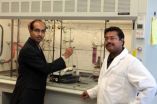(Press-News.org) Used in the proper amounts, it can make teeth stronger and aid in the treatment of osteoporosis. When excessive amounts are consumed, however, it can be a killer — a carcinogen that causes bone, lung and bladder cancers. The "it" is fluoride, a common additive in most American communities' drinking water and an ingredient in the vast majority of commercially produced adult toothpastes.
Determining the level of fluoride, be it in water, consumer products or the human body, is an important and attractive challenge for scientists. To address that, a Florida State University researcher has developed a molecular sensor that changes color when a sample containing fluoride is added to it.
"The U.S. Environmental Protection Agency recommends that 1 part per million (ppm) of fluoride ions is acceptable in drinking water, but above 2 ppm is considered a serious health risk," said Sourav Saha, an assistant professor in FSU's Department of Chemistry and Biochemistry (http://www.chem.fsu.edu/) and its Integrative NanoScience Institute (http://insi.fsu.edu/). "Because fluoride is carcinogenic even at such small doses, a sensor is needed to detect fluoride selectively at very low concentrations and in the presence of other naturally occurring and biologically important ions."
Working with a team of graduate students and postdoctoral researchers, Saha was able to develop just such a sensor. His research team discovered that a compound called naphthalene diimide (NDI) interacts with fluoride ions in a uniquely colorful way.
"NDIs are a family of neutral (albeit electron-deficient) aromatic compounds that are colorless until fluoride is added," Saha said. "A small amount of fluoride will quickly turn the sample orange, while a larger amount will turn it pink. In this manner, it becomes very easy to determine not only the presence of fluoride in water, but at what levels."
While other fluoride sensors exist, many of them cannot differentiate between fluoride and other anions — negatively charged ions — that might be present in the water.
"Although they can detect fluoride, they cannot accurately measure the levels of fluoride," Saha said. "Naked-eye detection of fluoride at different concentration levels is an advantage of NDI-based sensors. Our sensor relies on an electron transfer event from a fluoride ion to the NDI receptor for generating a visible response or signal, which in this case is color change. The electron transfer process can be reversed, and the sensor can be regenerated and reused over and over again."
By designing an appropriate sensor, Saha's laboratory has achieved a remarkable "nanomolar" sensitivity for fluoride, meaning it can detect about one ten-thousandth of a milligram of fluoride in a liter of water. This makes it one of the most sensitive fluoride sensors known to date.
Water fluoridation has been widely used in the United States since about 1960. Although often a subject of controversy, Saha says it has had the effect of improving overall dental health through a very basic chemical process. When added to water systems, fluoride reacts with a naturally occurring mineral, calcium phosphate, and produces a compound called fluorapatite. Fluorapatite then bonds with humans' teeth to form a hard, protective layer that wards off corrosion. This is important for dental health.
However, excessive amounts of fluoride in water can cause a condition known as dental fluorosis, especially in young children. This results in a mottled appearance of the dental enamel, as well as possible cracking and pitting of the teeth.
Fluoride is also used in several drugs prescribed to treat the brittle-bone disease osteoporosis. Given in the proper amounts, the fluoride appears to stimulate the formation of new bone tissue. However, when excessive amounts of fluoride build up in body tissues, they can lead to a variety of health maladies, including skeletal fluorosis, which causes pain and damage to bones and joints. Excessive fluoride over a length of time has also been linked to the development of osteosarcoma — a malignant and potentially fatal bone cancer — as well as cancers of the lungs and bladder. For those reasons and others, fluoride has not been formally approved by the Food and Drug Administration for the treatment of osteoporosis in the United States.
Artificial fluoridation of drinking water is commonly practiced in many industrialized nations. While precise numbers are unavailable, perhaps 400 million people living outside of the United States are located in areas where water is artificially fluoridated, according to the British Fluoridation Society. Untold millions of others, especially in parts of Africa, India and China, rely on water sources whose natural fluoride levels exceed EPA recommendations. Efforts to measure the amount of fluoride present in many of those areas are inconsistent and imprecise.
"This is a very significant public health issue worldwide," Saha said. "Some developing countries fluoridate their water but don't have a means for measuring it accurately. Others are drinking water that hasn't been treated with fluoride but that might already contain dangerous amounts naturally. Clearly there is a critical need for a fluoride sensor that can tell people whether their water supply is safe."
A paper describing his team's findings was recently published by the Journal of the American Chemical Society. "Fluoride Ion Sensing by an Anion-n Interaction" (http://pubs.acs.org/doi/abs/10.1021/ja107382x) was coauthored by Saha and his postdoctoral researcher, Samit Guha. It was also highlighted in the Dec. 6, 2010, issue of Chemical and Engineering News (http://pubs.acs.org/cen/).
In addition, Saha filed for a U.S. patent on his fluoride-sensing process in June 2010; he hopes to know within the next year whether the patent will be granted. If it is, the next step likely would be to license his discovery to an outside company that could test it for commercial potential and then, if all goes well, develop it into a marketable product.
"This is a clever idea," said John Fraser, Florida State's assistant vice president for Research and Economic Development and director of the Office of Intellectual Property Development and Commercialization (http://www.research.fsu.edu/techtransfer/). "Using a simple color test to determine safe fluoride levels will lead to a tangible benefit to society. Once commercialized, people will benefit in the United States, but also in countries with high natural but unsafe levels of fluoride."
INFORMATION:
Researcher develops accurate method for detecting dangerous fluoride
Sourav Saha's molecular sensor could protect people from a potential carcinogen
2010-12-10
ELSE PRESS RELEASES FROM THIS DATE:
Official food allergy treatment guidelines released
2010-12-10
A collaborative, government-led effort to guide and standardize diagnosis, treatment and management of food allergies has resulted in the release of an official set of recommendations for physicians.
The guidelines are being published online this week by the Journal of Allergy and Clinical Immunology (JACI), and available online at www.niaid.nih.gov/topics/foodallergy/clinical/Pages/default.aspx. They were developed by the National Institutes of Health and leading researchers and clinicians, professional and patient advocacy organizations, and the American Academy of ...
Hospital shootings rare, but rate of other assults high, Johns Hopkins researchers find
2010-12-10
Shootings like the one in which a gunman shot a doctor and killed a patient at The Johns Hopkins Hospital in September are "exceedingly rare," but the rate of other assaults on workers in U.S. health care settings is four times higher than other workplaces, conclude two Johns Hopkins emergency physicians after reviewing workplace violence in health settings.
The rate of assault in all private-sector industries in the United States is two per 10,000, compared to eight per 10,000 at health care workplaces, note Gabor D. Kelen, M.D., and Christina L. Catlett, M.D., in a ...
Buprenorphine is better than methadone for opioid dependence in pregnant women, study shows
2010-12-10
Using buprenorphine instead of methadone — the current standard of care — to treat opioid-dependent pregnant women may result in healthier babies, suggests new findings from an international team led by Johns Hopkins researchers and published in the Dec. 9 issue of the New England Journal of Medicine.
Babies born to mothers taking buprenorphine instead of methadone to counter heroin and/or prescription opioid addiction were likely to need less morphine to deal with drug withdrawal symptoms, spent half as much time in the hospital after delivery and recovered from neonatal ...
There's a new 'officer' in the infection control army
2010-12-10
Johns Hopkins scientists have identified a previously unrecognized step in the activation of infection-fighting white blood cells, the main immunity troops in the body's war on bacteria, viruses and foreign proteins.
"It's as if we knew many of the generals, colonels and majors and now we have discovered a new officer that helps the troops carry out the right battle plan," says Joel Pomerantz, Ph.D., an assistant professor of Biological Chemistry in the Institute for Basic Biomedical Sciences and member of the Institute for Cell Engineering at Johns Hopkins.
The discovery, ...
On...off...on...off... The circuitry of insulin-releasing cells
2010-12-10
A myriad of inputs can indicate a body's health bombard pancreatic beta cells continuously, and these cells must consider all signals and "decide" when and how much insulin to release to maintain balance in blood sugar, for example. Reporting in Nature Chemical Biology last month, researchers at the Johns Hopkins University School of Medicine have teased out how these cells interpret incoming signals and find that three proteins relay signals similar to an electrical circuit.
"Pancreatic beta cells are influenced by hormonal, metabolic and electrical signals and something ...
Gene that causes some cases of familial ALS discovered
2010-12-10
Using a new gene sequencing method, a team of researchers led by scientists from Johns Hopkins and the National Institutes of Health has discovered a gene that appears to cause some instances of familial amyotrophic lateral sclerosis (ALS). The finding could lead to novel ways to treat the more common form of this fatal neurodegenerative disease, which kills the vast majority of the nearly 6,000 Americans diagnosed with ALS every year.
Researchers don't know exactly what causes ALS, which destroys the motor neurons that control the movement of all the body's muscles, ...
A new kind of blast-resistant glass
2010-12-10
Whether in a hurricane, tornado, or bomb attack, a leading cause of injury and death is often fast-flying shards of glass. Explosions and high winds can cause windows in buildings to shatter-spewing jagged pieces of glass in every direction.
A Pentagon report on the 1996 Khobar Towers bombing in Saudi Arabia, for example, noted:
Two of the 19 deceased had injuries know to be caused by glass fragments that were severe enough to cause death even without other contributing forces. Of the remaining 17 deceased, 10 had glass injuries that were significant and which may ...
Lowering the drinking age is unlikely to curb college binge drinking
2010-12-10
Although presidents at some U.S. colleges have argued that lowering the minimum legal drinking age could help curb binge drinking on campuses, a new study in the January issue of the Journal of Studies on Alcohol and Drugs suggests such a measure would be ineffective.
In 2008, a group of college presidents and chancellors formed the Amethyst Initiative, a call to rethink the current minimum legal drinking age of 21. They argue that the law encourages underage college students to drink at parties, where binge drinking is common. The main argument states that if students ...
New way found of monitoring volcanic ash cloud
2010-12-10
The eruption of the Icelandic volcano Eyjafjallajökull in April this year resulted in a giant ash cloud, which – at one point covering most of Europe – brought international aviation to a temporary standstill, resulting in travel chaos for tens of thousands.
New research, to be published today, Friday 10 December, in IOP Publishing's Environmental Research Letters, shows that lightning could be used as part of an integrated approach to estimate volcanic plume properties.
The scientists found that during many of the periods of significant volcanic activity, the ash plume ...
Paris, Sensitivity and Words - "I'm So Afraid" - a Duet by Diane Marino and Robert Lauri
2010-12-10
Diane Marino, talented US jazz artist known in Europe
Take an accomplished singer, a talented pianist, and experienced arranger, combine them, and you get the dynamic and dazzling artist known as Diane Marino.
She combines solos that are sophisticated and elegant with expressive vocal pieces. With a warm and clear voice, Diana Marino reflects emotion in the simplicity of her vocal expression. Her albums combine "standards" with impressive versions of the bossa nova and samba, sung in Portuguese. Diane Marino offers us an "interpretation" in the truest sense and a ...
LAST 30 PRESS RELEASES:
Commercial water dispenser machines may contain more contamination than tap water
Death and doctors: New WSU study looks at medical student education on end-of-life care
The best hydrogen for heavy-duty transport is locally produced and green
Pregnancy-related high blood pressure varied among Asian, Pacific Islander subgroups
Measuring movement creates new way to map indoor air pollution
Europe’s crop droughts to get worse even as rain increases
New study identifies signature in blood to better predict type 2 diabetes risk
Research spotlight: developing “smart” nanoparticles to deliver targeted gene therapy in osteoarthritis
A CRISPR fingerprint of pathogenic C. auris fungi
Time warp: How marketers express time can affect what consumers buy
CBD treatment reverses key effects of fetal alcohol spectrum disorder in a mouse model
Blood sugar spikes linked to higher risk of Alzheimer's disease
Staying single for longer affects young people’s well-being
New method allows scientists to 3D-print structures within cells
Screening tool helps identify brain-related comorbidities in individuals with Duchenne muscular dystrophy
How do the active ingredients of monkfruit affect health?
News language and social networks: how do they affect the spread of immigration attitudes?
Researchers discover trigger of tendon disease
Your pet's flea treatment could be destroying the planet
Diabetes risk not associated with timing or type of menopause
Bulk inorganic crystals grown from water emit “handed” light
A new AI-based attack framework advances multi-agent reinforcement learning by amplifying vulnerability and bypassing defenses
While exploring the cosmos, astronauts also fuel explorations of the biology of aging and cellular resilience
Design and synthesis of Zr-IR825 nanoparticles for photothermal therapy of tumor cells
Food critics or food grabbers? When choosing food, wood mice split into careful examiners who sniff and handle, and quick nut grabbers
‘Cosmic clock’ reveals Australian landscapes’ history and potential future
Higher maternal blood pressure increases the risk of pregnancy complications, study concludes
Postoperative complications of medical tourism may cost NHS up to £20,000/patient
Phone apps nearly 3 times as good as no/basic support for quitting smoking long term
Female sex and higher education linked to escalating prevalence of obesity and overweight in Africa
[Press-News.org] Researcher develops accurate method for detecting dangerous fluorideSourav Saha's molecular sensor could protect people from a potential carcinogen


